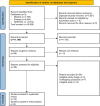Probiotic supplementation during antibiotic treatment is unjustified in maintaining the gut microbiome diversity: a systematic review and meta-analysis
- PMID: 37468916
- PMCID: PMC10355080
- DOI: 10.1186/s12916-023-02961-0
Probiotic supplementation during antibiotic treatment is unjustified in maintaining the gut microbiome diversity: a systematic review and meta-analysis
Abstract
Background: Probiotics are often used to prevent antibiotic-induced low-diversity dysbiosis, however their effect is not yet sufficiently summarized in this regard. We aimed to investigate the effects of concurrent probiotic supplementation on gut microbiome composition during antibiotic therapy.
Methods: We performed a systematic review and meta-analysis of randomized controlled trials reporting the differences in gut microbiome diversity between patients on antibiotic therapy with and without concomitant probiotic supplementation. The systematic search was performed in three databases (MEDLINE (via PubMed), Embase, and Cochrane Central Register of Controlled Trials (CENTRAL)) without filters on 15 October 2021. A random-effects model was used to estimate pooled mean differences (MD) with 95% confidence intervals (CI). This review was registered on PROSPERO (CRD42021282983).
Results: Of 11,769 identified articles, 15 were eligible in the systematic review and 5 in the meta-analyses. Quantitative data synthesis for Shannon (MD = 0.23, 95% CI: [(-)0.06-0.51]), Chao1 (MD = 11.59 [(-)18.42-41.60]) and observed OTUs (operational taxonomic unit) (MD = 17.15 [(-)9.43-43.73]) diversity indices revealed no significant difference between probiotic supplemented and control groups. Lacking data prevented meta-analyzing other diversity indices; however, most of the included studies reported no difference in the other reported α- and ß-diversity indices between the groups. Changes in the taxonomic composition varied across the eligible studies but tended to be similar in both groups. However, they showed a potential tendency to restore baseline levels in both groups after 3-8 weeks. This is the first meta-analysis and the most comprehensive review of the topic to date using high quality methods. The limited number of studies and low sample sizes are the main limitations of our study. Moreover, there was high variability across the studies regarding the indication of antibiotic therapy and the type, dose, and duration of antimicrobials and probiotics.
Conclusions: Our results showed that probiotic supplementation during antibiotic therapy was not found to be influential on gut microbiome diversity indices. Defining appropriate microbiome diversity indices, their standard ranges, and their clinical relevance would be crucial.
Keywords: Antibiotics; Diversity; Gastrointestinal microbiome; Meta-analysis; Probiotics.
© 2023. The Author(s).
Conflict of interest statement
The authors declare that they have no competing interests.
Figures




References
Publication types
MeSH terms
Substances
LinkOut - more resources
Full Text Sources

